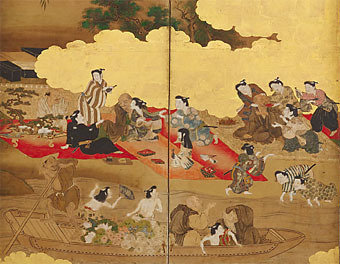Seasons: Japanese Screens
dal 23/12/2010 al 4/7/2011
Segnalato da
23/12/2010
Seasons: Japanese Screens
Smithsonian's Freer Gallery of Art, Washington
Two rotations highlight screens painted to represent various times of year. The exhibition will offer an intimate perspective on seasonal images by providing a "door-frame" view into the natural world. The screens provide detailed glimpses of nature, such as a single chrysanthemum, as opposed to a sweeping landscape.

The nearly two hundred screens held by the Freer Gallery constitute one of the most important collections of its type in the world. Ranging in date from the fifteenth to the nineteenth century, the screens represent the major thematic and stylistic examples of this popular format.
Particular strengths of the Freer collection of Japanese screens include works featuring detailed representations of daily life, in forms ranging from visual quotations from classical literature to celebratory depictions of bustling urban life of the seventeenth century. The omnipresent influence of revered Chinese aesthetic sensibilities can be seen in an array of ink monochrome landscapes, as can the influence of such Japanese artists as the early-seventeenth-century master Tawaraya Sotatsu (d. 1643), whose importance Charles Lang Freer (1854–1919) was the first Western collector to grasp. Sotatsu's revival of ancient court styles in a modern mode can be viewed alongside works by painters who carried on his lineage.
While most screens in the Freer collection are in their original format, some paintings were actually created for placement on sliding door panels. When the panels were destroyed or dismantled, fragments were salvaged and remounted on folding screens. Colorful early-seventeenth-century renderings of herons and pheasants that were part of a sliding door ensemble created for the Akashi Castle near Kobe serve as excellent examples of this restructuring. The paintings were rescued from a fire that destroyed the castle around 1635.
Modern expectations of traditional Japanese aesthetics are confounded by an important pair of six-panel screens by Kano Motonobu (1476–1559) that display a series of discrete ink monochrome landscape scenes set within a lush background of colored landscape and cloud-patterned gold leaf. This combination of austerity and flamboyance reveals a dimension of sixteenth-century Japanese taste that has yet to be thoroughly explored.
The exhibition will offer an intimate perspective on seasonal images by providing a "door-frame" view into the natural world. The screens provide detailed glimpses of nature, such as a single chrysanthemum, as opposed to a sweeping landscape.
Iage: Six-panel screen, Frolic at the Water's Edge. Kano Chikanobu, 1660–1728 Edo period, 1615–1868 Color and gold on paper HxW 176x381.9cm F1902.91
Press contact:
Amanda Williams 202.633.0504 williamsam@si.edu
Deborah Galyan galyand@si.edu
The Freer Gallery of Art, located at 12th Street and Independence Avenue S.W., and the adjacent Arthur M. Sackler Gallery, located at 1050 Independence Avenue S.W., are on the National Mall in Washington, D.C.
Hours are 10 a.m. to 5:30 p.m. every day, except Dec. 25, and admission is free.



